An Old Okinawan Karate Secret?
The Double Bone Block
By Ron van de Sandt
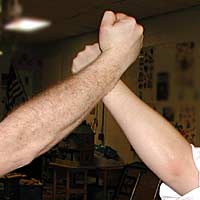 It was in the late 1970’s when I got my first clue that I was
on to something. It was in the late 1970’s when I got my first clue that I was
on to something.
I was just a green belt competing in kata in a large Midwestern open
tournament. In my kata, however, instead of doing a standard down block,
I used a modified version using the flat of my arm (double bone block)
that my teacher had taught me. I came in second. Then something interesting
happened. When the competition in my ring was over, an older Okinawan
teacher, a guest of honor at the tournament, came over and took me
aside. He was wearing a red and white belt so he must have been a seventh,
eighth or ninth degree black belt.
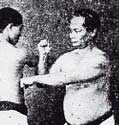 |
An old 1920’s photo of
the famed karate pioneer Choki Motobu executing a double bone forearm
block
|
This teacher said to me in broken English, “No block like this
(demonstrating the same down block as I had done), block like this.” He
then demonstrated a standard block using the side of his forearm. Then
he added the kicker. “Block like this (again using the outside
surface of the forearm to block), should not be shown.”
At the time, I didn’t think too
much about this statement. After all, the block I did was just what my
own teacher had taught. My teacher
had said it was a stronger block, one that had once been taught in
Okinawa, but was not seen much anymore.
Fast forward a couple of decades. I became a surprise participant in
a demonstration that all too graphically demonstrated the weakness of
a standard down block as used in karate. In October of 2002 I attended
a Midwestern Renaissance Festival and it had been raining all day. Late
in the afternoon as I was crossing a muddy path over a small wooden bridge,
my feet slipped. Without thinking I reached out with one hand to the
bridge’s rail to catch myself.
Later that day, I sat contemplating my aching, broken forearm. I thought
to myself, I wish I could say “that this was the result of trying
to defend myself against five big thugs.” But in reality I only
slipped in the mud. My left little finger side forearm bone broke about
two and one half inches above the wrist as it hit across the rail. And
the hit had not been very hard. Well, “Better my arm than my head,” I
thought to myself.
Then it occurred to me. The movement I had used to catch myself was
very similar to the movement used in a normal karate downward block.
At this point my mind flashed back to the Okinawan teacher and his words
at the tournament many years before.
If this little impact could break my forearm, how much in danger are
the forearms of karate-ka when they perform other basic blocks that make
contact with just one or the other of the two bones in the forearm? This
danger would be maximized at the very time the block was need most, and
especially against strong techniques, like a hard shin roundhouse kick
as done by Muai Tai (Thai Boxing) practitioners; or against a downward
strike of an attacker using a cue stick, baseball bat or police batten.
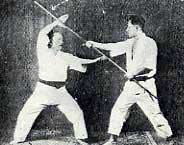 |
A rare photo of Gichin Funakoshi, who many consider the father
of Japanese karate, demonstrating an open hand two bone forearm block
against a downward staff (bo) strike. |
I then began thinking about the modified, double bone,
block taught by my teacher and several other Okinawan karate styles,
as well as the
mechanics behind it. This was what the Okinawan teacher had said many
years ago: “Block like this should not be shown.” I asked
myself, “Are these modified blocks a secret of old Okinawan karate,
something that in some styles is only shown to senior students?”
So, what are double bone blocks, what are their advantages, and how
are they applied?
A double bone block is any basic block that is modified by the wrist/forearm
position so both bones in the forearm make contact in a block rather
than just a single bone on the edge of the forearm. As normally preformed,
upper, downward and inside blocks twist the wrist and forearm so only
the outer, little finger side of the forearm bone makes contact. The
inside block does the same with the inside bone of the forearm. This
same two bone forearm principle can even be applied to two hand circular
blocks as often used in Goju Ryu and Uechi-ryu karate.
Some Basic Anatomy
|
|
The two bones
of the forearm
|
The middle
and upper forearm are cushioned with a layer of muscles.
|
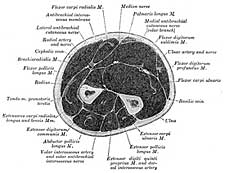 |
This section
view of the forearm shows the thickness of muscle padding
in the upper forearm.
|
Double bone forearm blocks have some very distinct advantages
over their single bone cousins. To understand these advantages
one must first look at the anatomy of the forearm, and then the
anatomy of a block.
If you hold your hand in a vertical fist position (with the outer
edge of the palm down, thumb up), you can feel for yourself the
two bones that run the length of the forearm. The upper, thumb
side bone is the radius and the little finger side bone is the
ulna. In this position (thumb up, little finger down) the bones
are positioned parallel to each other. In other positions, however,
such as the typical rotated fist karate punch, as a result of the
twisted forearm position the two bones actually cross.
On and near the wrist these bones have little muscle padding.
But as you proceed up the forearm, the muscles (including the extendor
digitorum communis and extendor carpa ulnaris) thicken and serve
to protect the underlying bones. In contrast, the sides of the
forearm have very little muscle padding, with the ulna (opposite
side from the thumb) having the least amount.
|
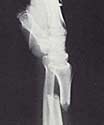 In karate, this bone is very susceptible to an
impact break. I have seen it often in practice fighting. A student
tries to block a front kick, but instead of sweeping the kick to
the side with a downward block, the unfortunate student just lowers
his or her forearm horizontally to block the vertical kick and “snap.” Shins
are a lot bigger and stronger than an ulna bone. In karate, this bone is very susceptible to an
impact break. I have seen it often in practice fighting. A student
tries to block a front kick, but instead of sweeping the kick to
the side with a downward block, the unfortunate student just lowers
his or her forearm horizontally to block the vertical kick and “snap.” Shins
are a lot bigger and stronger than an ulna bone.
I have also seen students break their forearms when trying to do
basic blocks against weapons. Here is an X-ray of a student who tried
to use a standard middle outside block against a staff (bo). You
will notice that the forearm bone just above the thumb suffered a
clean break.
|
A double bone block is much stronger. Any impact is spread across two
bones. Thus, structural strength is doubled. Impact is further dissipated
by the muscle padding.

Nerves
|
But that’s not all. Looking at the illustration, notice
that on both sides, next to the two forearm bones there are nerves
-- the lateral and medial antibrachial cutaneous. If struck, these
nerves can cause a lot of pain. Of course, in some traditional
styles of Okinawan karate, practitioners have spent years doing
toughening and deadening exercises. For these students the pain
of impact to this area will be less intense.
On either side of the forearm, you will also find two major arteries
(radial and ulner) and branches of another (brachial). Of the two
branches, the ulnar artery is the largest, itself having four branches
in the forearm. Both arteries are close to the surface of the arm,
near the wrist, and lying next to the bones. Likewise, major veins
run through the forearm and wrist.
If either of the two bones in the forearm is broken there is danger
of collateral damage. The sharp or jagged edge of the broken bone
can easily tear into, penetrate or sever nearby arteries, veins or
nerves. |

Arteries
|
Demonstrating The Double Bone And Single Bone Blocks
Now look at the differences between the two blocks (standard and
double bone), first using a low block as an example. In the single
bone block (the version almost universally taught), the blocking
surface is either the fatty part of the fist on the pinky side of
the hand, or more often the outside of the forearm near the wrist.
If it is the outside of the forearm, the impact hits the ulna bone,
while also impacting the nerve and artery that lie close to the surface. |
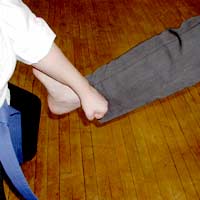 |
By simply turning the hand so the thumb is up (the same structural
position as a vertical fist), the block changes. Any impact is absorbed
across both bones (double bone block) and is cushioned by the muscle
on the outside of the forearm. Nerves and arteries are thus less
likely to be damaged. |
|
A word of caution, however. If you are trying to block a front kick
this way, be careful. If you make contact with the top of the hand rather
than the outward surface the forearm, you could be easily hurt. There
are many bones in the back of the hand that can easily break, such as
the carpus and metacarpus bones. If the top of your hand connects with
the ankle or shin of a kicking (rising) foot, you could be in a world
of hurt.
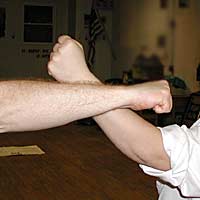 |
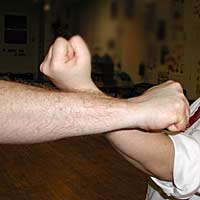 |
A close up of an inside block (some styles of karate call this
an outside block) which has been modified so that the block makes
contact with the top of the forearm buttressed internally by its
two bones and padded by overlaying muscle. Compare the arm position
here with the photo at right. |
A standard inside block that makes contact only with the outside
bone of the forearm. |
The same concept of double bone contact also applies to the middle inside
(seen above) and outside blocks as well as the upper block. The way middle
blocks are usually taught is that the forearm twists as it moves, ending
up with the palm of the hand facing toward you and only one bone (radius
or ulna) making contact against a target. These blocks can become double
bone blocks with only a simple change in forearm position. In either
case if the thumb side of the hand is up at the moment of contact, both
bones padded by overlying muscle will make contact rather than only one
bone without padding.
In the normal upper block the wrist is turned so the little finger forearm
bone makes contact (photo at left above). If instead the wrist is turned
so the thumb is up, the forearm is again positioned (both bones parallel)
so any impact will be absorbed across both bones, and padded by muscles
if the blow is absorbed on the middle or upward forearm (right photo
above).
Double Bone Blocks Are Also Stronger
Anatomically, the double bone block also provides more strength and
leverage to the block. Try this as an experiment. Slowly using a standard
outward block with your right hand (with the palm facing you, thumb to
the outside), have someone resist its action (from the right) at the
wrist. Now try turning the fist slightly until the palm is facing left
(thumb upward). Again, have someone resist its action at the wrist. Which
is stronger? Then do a right upper block, turning your palm facing front,
have someone pull down on the arm at the wrist. Now turn the palm to
face toward the ground, and lower the elbow so the forearm is at about
a 45 degree angle. Again, have someone pull down at the wrist. Which
is stronger?
If you’re not familiar with double bone blocks, experiment using
the double bone block versions for upper blocks, lower, middle and outward
blocks, and see what happens. But be careful, and do so under the watchful
eyes of a qualified instructor.
Does this mean that we should always do nothing but double bone blocks?
The answer is, of course, no. Each block can be valuable, and have its
own purpose, advantages, and disadvantages. For example, as noted above,
if you attempt a lower double bone block against a front snap kick, you
stand a chance of catching the opponent’s ankle bone with the top
of your hand. Equally, you would not want to attempt a double bone inside
block against a trusting knife attack because this would expose the arteries
and ligaments of the inside of the wrist and lower arm to injury. In
other situations a blocking hand, wrist or forearm only lightly guides
or slides past an attack to move it or hold it away from its target.
Here speed and agility rather than structural strength is needed. In
other situations the single edge of a forearm can be used to strike into
a soft nerve area of pressure point area.
On the other hand, double bone blocks offer extra structural strength.
This is often needed to protect your forearm and yourself when blocking,
or absorbing powerful kicks, strikes or other blows, such as in a weapon
attack – especially against anything with a hard surface.
With practice you should be able to tell which block is most appropriate
for you against any given technique and in what circumstance.
Here you may be asking yourself: “If I have not been shown this
type of block by my teacher or if I haven’t practiced it in my
style of karate, has my training been incomplete?” The answer is
that you have all the training and tools, but may just not be aware of
how to use what you have been taught. You may have been doing these blocks
all the time but didn’t realize what you were doing was a hidden
variation of the two bone forearm block whose secret was timing.
Take the standard upper or rising block. The blocking arm usually moves
as follows: the blocking arm starts with the palm side of the forearm
facing the body, and then as the block rises, the forearm rotates with
the wrist upward and the radius (little finger side) bone makes contact.
Just a little change in timing can turn this same block into a double
bone block. Simply by not fully rotating your forearm before contact
the upper side of the forearm and thus both bones and muscle padding
will absorb the initial impact. Without stopping, however, you continue
to rotate the wrist outward to a position where the little finger side
of the wrist is upward. This movement in effect redirects an attack upward
and past the forearm.
This means that using the same movement you already know, you can perform
either a single bone or double bone block. The only difference is the
timing you use in the execution of the technique.
In similar fashion other basic karate blocks (inside, outside and downward)
can be modified in execution so they make contact as double bone blocks,
but then continue to rotate to redirect the attack.
To the casual observer a two bone blocks performed this way would look
virtually the same as a standard single bone block. Seen this way, an
old Okinawan secret is contained within each block most karate-ka perform.
And, from experience I can tell you, the next time you find yourself
slipping in mud and having to block a fence rail, I would recommend that
you remember to use the mighty double bone block as your block of choice.
Otherwise you might find yourself writing an article such as this.
About the Author:
Ron van de Sandt has been in the martial arts since 1972 and has studied
American Kempo, Shorin Kempo and Sholin Karate - a blend of Shorinji
Ryu and Shorin Ryu Karate. Mr. van de Sandt currently holds a Dan rank
in Sholin Karate, and runs the Sholin Karate Club, at the Fairborn YMCA,
Fairborn, Ohio. He is a frequent contributor to FightingArts.com.
|